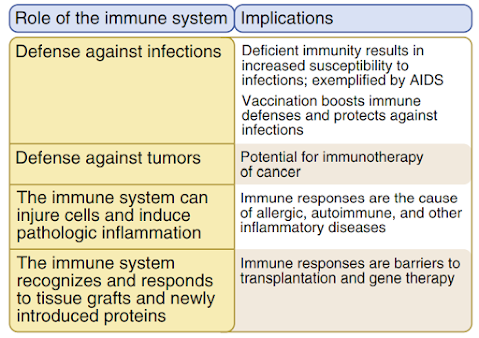Acute Inflammation
ACUTE INFLAMMATION
Previously we discussed the types of inflammation briefly and in here we will know more about acute inflammation
general features of inflammation
Before discussing acute inflammation exclusively, we should
know the general pathway of inflammation which is described below
Due to the presence of an injurious agent or dead cells or
tissue damage the phagocytes present in the tissues or organ try to eliminate
the causative agent. Along with killing abilities the also has release soluble
substances which cause inflammation and also act as mediators which help the
leukocytes to reach the affected place.
There are three basic steps in the acute inflammation
1.
Dilation
of small vessels, leading to an increase in blood flow,
2. Increased permeability of the
microvasculature, enabling plasma proteins and leukocytes to leave the
circulation, and
3. Emigration of the leukocytes from the
microcirculation, their accumulation in the focus of injury, and their
activation to eliminate the offending agent
We will discuss them briefly here
1.
REACTION OF BLOOD VESSELS IN ACUTE
INFLAMMATION- Dilation of small vessels, leading to an increase in blood
flow,
The vascular reactions of acute
inflammation consist of changes in the flow of blood and the permeability of
vessels, both designed to maximize the movement of plasma proteins and
leukocytes out of the circulation and into the site of infection or injury.
These include the blood vessels and the lymphatics
Often the plasma proteins and the leukocytes that accumulate
in the place of inflammation gets accumulated in different forms
a) exudate- this fluid is high in protein content and all the dead cells
and leukocytes that were used during the inflammation. This form of the liquid has
a whitish-yellow color and we in common terms call it pus.
b) transudate- it is a basic clear fluid, can be considered as the
ultrafiltrate of the blood plasma. It has very little protein content and is
mostly produced due to osmotic imbalance. The osmotic imbalance can occur
during vasodilation.
c) edema- it can be an exudate os transudate and is a fluid buildup in the serous
layer or the interstitium.
LEUKOCYTE RECRUITMENT TO SITES OF INFLAMMATION- Increased
permeability of the microvasculature, enabling plasma proteins and leukocytes
to leave the circulation
a)
Leukocytes are recruited from the blood into
the extravascular tissue where infectious pathogens or damaged tissues maybe
located, migrate to the site of infection or tissue injury, and are activated
to perform their functions.
b)
Leukocyte recruitment is a multistep process
consisting of loose attachment to and rolling on endothelium (mediated by
selectins); firm attachment to the endothelium (mediated by integrins); and
migration through interendothelial gaps.
c)
Various cytokines promote the expression of
selectins and integrin ligands on endothelium (TNF, IL-1), increase the avidity
of integrins for their ligands (chemokines), and promote directional migration
of leukocytes (also chemokines). Tissue macrophages and other cells responding
to the pathogens or damaged tissues produce many of these cytokines.
d)
Neutrophils predominate in the early
inflammatory infiltrate and are later replaced by monocytes and macrophages.
LEUKOCYTE ACTIVATION AND REMOVAL OF
OFFENDING AGENTS
a)
Leukocytes can eliminate microbes and dead cells
by phagocytosis, followed by their destruction in phagolysosomes.
b)
Destruction is caused by free radicals (ROS, NO)
generated in activated leukocytes and by granule enzymes.
c)
Neutrophils can extrude their nuclear contents
to form extracellular nets that trap and destroy microbes.
d)
Granule
enzymes may be released into the extracellular environment.
e)
The
mechanisms that function to eliminate microbes and dead cells (the physiologic
role of inflammation) also are capable of damaging normal tissues (the
pathologic consequences of inflammation).
f)
Anti-inflammatory mediators terminate the
acute inflammatory reaction when it is no longer needed.



Comments
Post a Comment